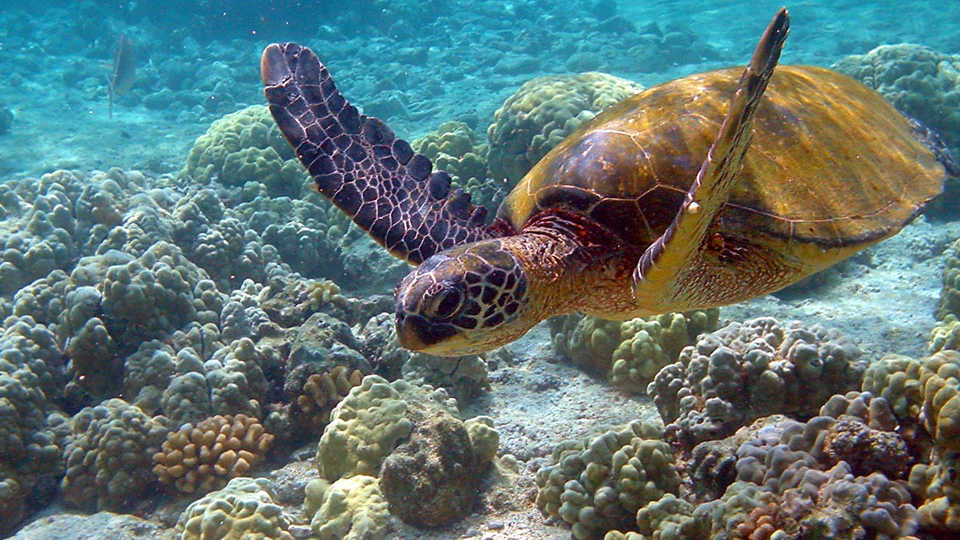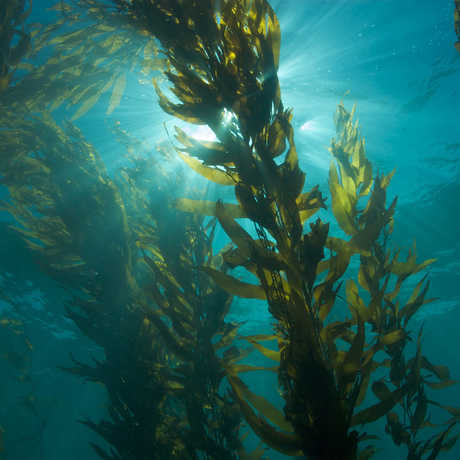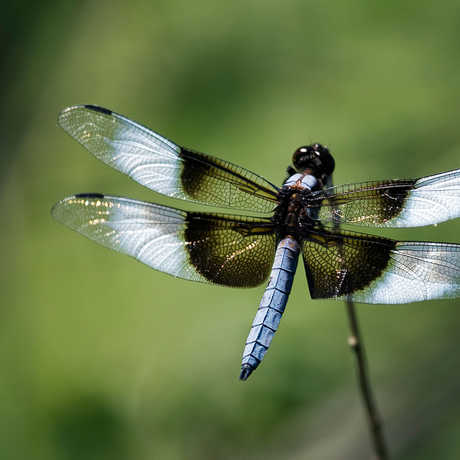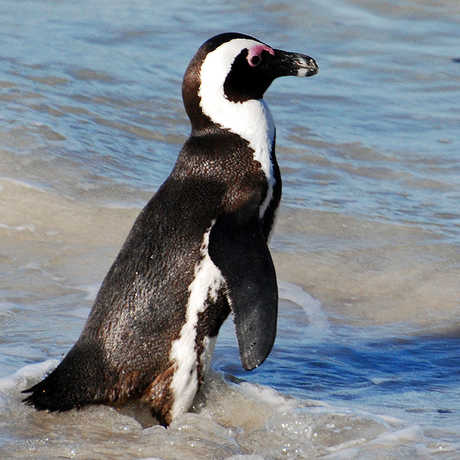- Learn that organisms are adapted to be well suited to survive in their environment.
- Construct explanations about how external structures of marine animals might serve to help these marine animals survive in their habitats.
- Infer the preferred habitat of marine organisms based on their physical characteristics.

© Brocken Inaglory
The ocean is home to a vast array of animals, partly because there are so many habitats within the sea. In this activity, students will learn about common adaptations seen in three habitats and then make predictions about what animals call that area home. This activity may be done as individuals or in groups, and serves as an excellent follow-up after a visit.
- Habitat Worksheet (one for each student or group of three, plus an extra)
- Animal Cards (one set for each student or group of three, plus an extra set)
- Scissors (if working as individuals)
- Colored pencils
- Tape or glue sticks
- habitat: a place where plants and animals live
- adaptation: what a plant or animal has or does that helps them live
- Introduce the idea of adaptations by asking your students “what about our bodies make us really good at living on land?” Answers may include things like feet and legs, hands and arms, standing upright, and breathing air. These are all examples of adaptations that humans have.
- Show students pictures of the three marine habitats you are focusing on: coral reefs, open ocean, and sandy bottom (if this activity is being done as a follow-up to visiting the Academy, you can have students try to recall what these habitats looked like). Discuss what adaptations animals would need to live in these habitats and write their ideas on the board. Teacher tip: Some of the habitats are home to multiple types of adaptive strategies; for example, the open ocean is home to strong swimmers and free floaters. Be sure to guide them to this conclusion so they are not completely stumped when doing the activity.
- Introduce the activity. They will be making predictions on where different animals live based on their adaptations. Teacher tip: Depending on your classroom needs and time available, you may have them do this as individuals or groups. Instructions for individuals and groups are both outlined below.
- Pass out one Habitat Worksheet to each student. Have them color their habitat for a few minutes. Be sure to have them write their name(s) at the top. (Working in groups: Arrange students in groups of 3. Pass out one Habitat Worksheet to each group. In each group, one student can color the sand, one student can color the reef, and one student can color the open ocean.)
- Pass out one set of Animal Cards to each student. Review what color adaptations these animals have before students color them in. After coloring, students cut them out. (Working in groups: Pass out one set of pre-cut Animal Cards to each group. Each student will be responsible for coloring 4 animals. This may be assigned by the teacher or chosen by the students.)
- With tape or glue, students will attach their animals to the correct section of the Habitat Worksheet. Encourage students to discuss their predictions with their neighbors. Remember – many of these animals are found in multiple habitats, so encourage students to place them where they think they are most often found or on the border between habitats. Each habitat should have multiple animals. (Working in groups: Students will work together to place their animals on the Habitat Worksheet.)
- Once finished, have students put their Habitat Worksheets up on the board or around the room for others to see. Give students time to look at other’s predictions and discuss each other’s work.
- Gather the students as a group and post an extra Habitat Worksheet on the board. They will need their own Habitat Worksheets as well.
- One at a time, take each animal picture and ask the students which habitat they placed it in.
- Discuss their answers and then model placing each animal in the appropriate habitat. Make sure to emphasize what enables these animals to survive in their specific environment.
- Between the discussions for each animal, you can give students the option to re-examine their choices and change their animal placements.
Assign or let each student choose one of the habitats. Using the adaptations discussed earlier, have students each design an animal that could survive in that habitat. The animal must have at least three adaptations.
Coral Reefs
Coral reefs are underwater ecosystems created by the calcium carbonite structures secreted by corals. Corals themselves are animals; they are invertebrates and are closely related to anemones and jellies. The habitats they create over long periods of time are recognized as being some of the most biodiverse habitats on earth. While most coral reefs are shallow and tropical, there are also cold water corals and deep water corals in some parts of the world. For the purposes of this activity, we will use the term “coral reefs” to refer only to shallow, tropical coral reef ecosystems.
Animals that survive well in coral reefs will have adaptations that allow them to live in a habitat with a lot of structures. Fish will be small and slender, allowing them to navigate between corals or hide in the cracks. These fish are often brightly colored, advertising messages like what sex they are or defense mechanisms. Invertebrates found in coral reefs, including the corals themselves, are either slow or stationary, with adaptations that keep them anchored down to the reef so they’re not swept up in the current.
Sandy Bottom
The sandy bottom is just that – the sandy bottom of our ocean! Although it may not have the splendid coloration of a coral reef, this is also a vibrant habitat. Very small animals live between the grains of sand while larger animals, like stingrays and different species of flatfish, bury themselves beneath it to ambush prey. (SaveMortonBay.org)
Sandy bottoms lack the structure of coral reefs, so these animals have adaptations that allow them to live on one plane. Fish found on the sandy bottom will be flat, with their belly resting on the sand and their eyes above. They will often be a drab, neutral color that will blend in with sand. Invertebrates in this area are not good swimmers, so they will remain on the floor.
Open Ocean
The open ocean, or pelagic zone, is entire column of water that exists between the surface of the sea almost down to the bottom. The pelagic zone occupies 1,330 million km3 (320 million mi3) with a mean depth of 3.68 km (2.29 mi) and maximum depth of 11 km (6.8 mi) (Charette MA and Smith WHF 2010). Depending on the depth, the pelagic zone is divided into five layers: epipelagic, mesopelagic, bathypelagic, abyssopelagic, and hadopelagic. Epipelagic is the top layer and receives the most amount of sunlight, while the hadopelagic layer (named for the Greek underworld Hades) is only found in the deepest ocean trenches and is home to the least amount of life. The bathypelagic, abyssopelagic, and hadopelagic layers are all similar in their lack of light; in fact, many biologists combine them into a single zone. The animals in this activity may all be found in the epipelagic zone.
Most vertebrates in this habitat are strong swimmers. They are often large, like whales or sharks, or swim in schools, like anchovies. There’s not much to camouflage into in this habitat, so colors follow the rules of counter-shading: darker on the top with a light colored belly. This allows animals to blend in with the dark ocean beneath when being looked down upon, but blend in with the sunlit waters above when being spied from below. Many invertebrates here are plankton: free floating with limited swimming ability.
Animal Information
While there are exceptions to every rule, the table on page 2 gives a general outline on where these animals may be found.
Disciplinary Core Ideas
- LS1.A: Structure and Function: Plants and animals have both internal and external structures that serve various functions in growth, survival, behavior, and reproduction.
- LS4.C: Adaptation: For any particular environment, some kinds of organisms survive well, some survive less well, and some cannot survive at all.
- LS4.D: Biodiversity and Humans: There are many different kinds of living things in any area, and they exist in different places on land and in water.
Cross Cutting Concepts
- Patterns: Patterns in the natural and human designed world can be observed, used to describe phenomena, and used as evidence. (K-2) Patterns can be used as evidence to support an explanation. (3-5)
- Structure and Function: The shape and stability of structures of natural and designed objects are related to their function(s). (K-2) Substructures have shapes and parts that serve functions. (3-5)
Related Performance Expectations
- 2-LS4-1. Make observations of plants and animals to compare the diversity of life in different habitats.
- 3-LS4-3. Construct an argument with evidence that in a particular habitat some organisms can survive well, some survive less well, and some cannot survive at all.
- Charette MA and Smith WHF (2010) "The volume of Earth's ocean" Oceanography, 23(2): 112–114.
- Save Morton Bay. Accessed April 28, 2015.


